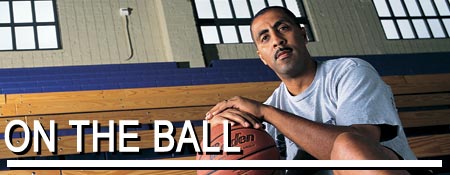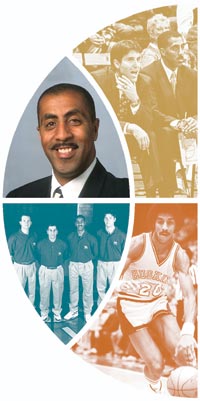
Heading North
A sports nut ever since he can remember, Romar always loved basketball most of all. But for years, his dreams far exceeded his reach. He was cut from his high school team as a 5-foot-6 sophomore and a junior but made the team as a senior-only to be benched after the season opener. Frustrated at his benching, he talked back to his coach and was suspended from the team. With no colleges interested in an undersized, inexperienced guard with an attitude, he decided to try out at Compton Junior College, just blocks from his home. The coach politely told him to get lost.
His dreams of playing college and pro ball seemed at a dead end. He wasn't ready to give up, though, and went to try out at nearby Cerritos Junior College. His freshman year wasn't anything special, but as a sophomore, he averaged 14.1 points a game, set a school record for single-season assists, and earned first-team all-league honors. Cerritos (23-8) made the state tournament, where Romar played spectacularly. Many people noticed-including Marv Harshman.
Harshman, then the UW coach, had come to Los Angeles to scout a highly touted guard in the tournament's 9 p.m. game. But after seeing Romar in the early evening game, he wanted him instead. A visit to Seattle—which included a cruise on Lake Washington—won Romar over in a second. (So did the purple Converse sneakers Harshman sent Romar—that was legal back then.)
Overcome with excitement, Romar and a friend drove 21 straight hours from Southern California to Seattle. Upon wheeling into campus, Romar poked his head in the IMA, saw a game in progress, dashed back to the car, got his stuff, and went to play—for four solid hours.

Clockwise from top: Romar (sitting with Steve Lavin) made UCLA into a winner. Romar was the Huskie's point guard from 1978-80. Romar and his fellow coaches at UCLA. Romar was a beloved figure at St. Louis University.
Photos (clockwise from top): Courtesy UCLA; Courtesy Husky Media Relations; Courtesy UCLA; Courtesy St. Louis University.
A swift, 6-foot-1 point guard with a cool head, Romar made an immediate impact on the Husky team. "You could tell he was a great player, but more than that was the way he treated us," recalls teammate Steve Matzen, '80. "He had a great ability to communicate with everyone on the team. He made you feel a part of everything—even when he poked fun at you."
Romar played two years with the Huskies, going 11-16 and 18-10. The team captain as a senior, he was twice voted most inspirational player by his teammates. One reason was his knack of playing great against the best opponents. For instance, in a 72-70 upset of UCLA at Pauley Pavilion in 1980, Romar went 6 for 6 from the floor, 6 for 6 from the free-throw line, had four assists and no turnovers. "He played a perfect game," former teammate Stan Walker recalls.
But Romar admittedly had one downside—he was a far better student of the game than in the classroom. "I wasn't serious about my studies," Romar admits. "Basketball was everything to me. I was the first person in my family to go to college, but I didn't take my schoolwork seriously." By the end of his senior year, he did not have enough credits to graduate, and his NBA dreams were thought to be pure fantasy. After all, the NBA doesn't take too many 6-foot-1 guards who don't score a whole lot (he averaged 9.3 points as a UW senior).
The Golden State Warriors took a flyer on him, grabbing him in the seventh round of the 1980 NBA draft. (Romar learned about it while shooting baskets in the IMA, of course), giving him a microscopic chance.
When he showed up at camp as an anonymous rookie competing for a job against stars like Bernard King and NBA scoring leader World B. Free, Romar was awed. "I saw all these big players and I thought they were the forwards," he recalls. "I couldn't believe it when they told the guards to get in one line, and they all joined me."
"Every night after practice, he was my first cut," recalls Al Attles, then the Warrior coach and now a Warrior vice president. "I don't mean to sound harsh, but he was just practice fodder. He had no chance. But every night, I would think, Gee, he actually did something nice in practice today, let's keep him one more day."
What made the impression on Attles? "I made sure to stay after practice, even the two-a-days," Romar says. "I would do a few dunks to show them, 'Hey, I am not tired. I am excited to be here.' " Sound familiar?
- Page 3: People Are Just Drawn to Him
- Page 4: The Secret to Success
- Return to September 2002 Table of Contents